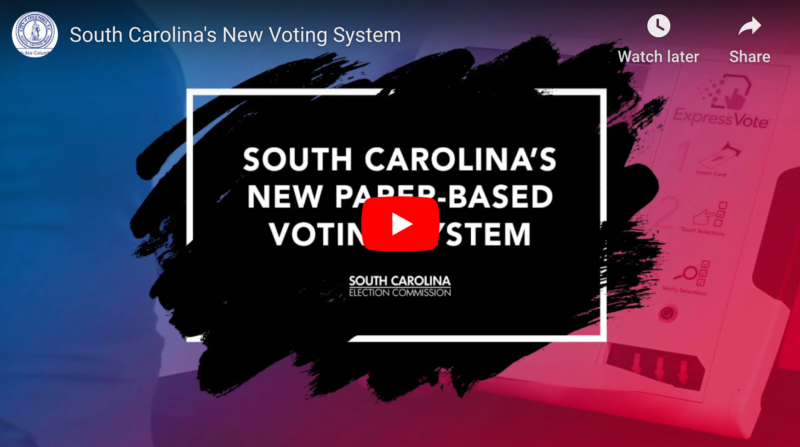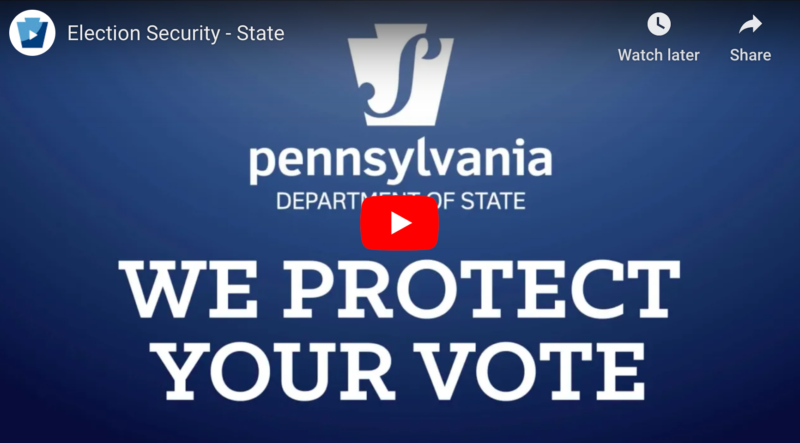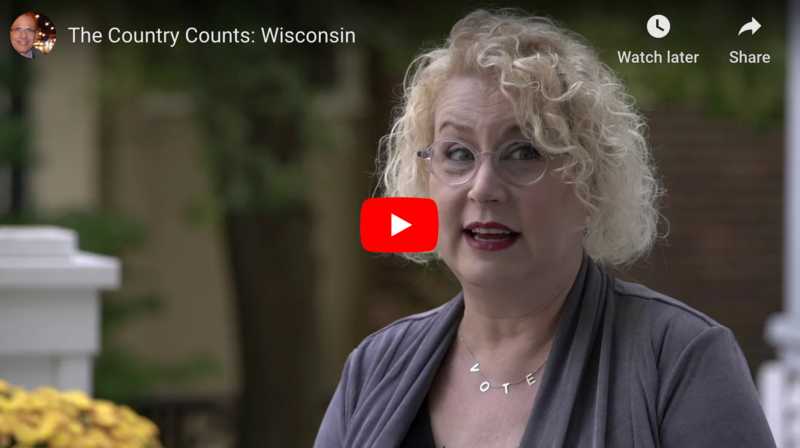30 Ways Election Officials Boost Voter Confidence and Trust
This round-up was featured in our ELECTricity newsletter in December 2020. (Note: This is a round-up of what election offices across the country are doing; CTCL does not have official policy recommendations). Sign up to receive more success stories from election offices across the country.
It’s no surprise that many voters are concerned about the legitimacy of elections and the integrity of their results. Prior to the November election, only 59% of voters were at least somewhat confident that the election would be conducted fairly and accurately. Election administrators can play a key role in facilitating the acceptance of election processes. That’s why we’ve rounded up 30 ways that election officials can boost voter confidence and trust in voting systems. Of course, elections aren’t one-size-fits-all, so we encourage you to draw inspiration from the ideas you like, and feel free to ignore the ones you don’t.
We’ve broken up these ideas into two main categories. First, we discuss strategies that election offices can implement both before and after elections, such as testing equipment and conducting audits. While these strategies are critical, they will not necessarily increase voter confidence unless the public actually knows about them. That’s why in the second section, we’re highlighting the ways that election officials can communicate with the public to assure them that the election process is both fair and secure.
For more information about increasing transparency and voter confidence, we recommend watching three of our online training series: Communicating Trusted Election Information, Cybersecurity for Election Officials, and Post-Election Audits.
Categories:
Strategies that Boost Trust
Before an Election:
1. Utilizing Ballot Tracking Systems. With mail-in voting becoming increasingly popular this year due to the COVID-19 pandemic, voters were concerned their ballots would be misplaced or delivered late. In order to assure voters that their ballots were accepted, election officials in states like Georgia, Maine, and North Carolina implemented online ballot tracking systems this year. These systems inform voters when their absentee ballots were mailed out, received, and counted. In some states like Colorado, voters can receive notifications via phone, email, or text about the status of their ballots. Today, such systems are becoming more and more popular, with 44 states and D.C. offering online ballot tracking.
2. Updating Voting Machines. When budgets allow, updating outdated voting machines is an excellent way to boost voters’ trust in the election process. In Pulaski County, Arkansas, the election commission introduced new voting equipment for the November election, replacing 15-year-old machines that utilized 30-year-old technology. Sometimes it’s a bad idea to roll out new equipment for the first time during a big election, which is why the election commission trained several staff members on troubleshooting the new voting machines to ensure that early voting and Election Day would run smoothly. The new machines print out a paper ballot that voters can check to ensure that their ballot was marked properly. Other states, including Georgia and South Carolina, similarly implemented new paper record voting machines within the past year to boost voters’ trust. (For guidance on writing a request-for-proposal, check out our RFP How-To Guide for Election Officials).
3. Testing Voting Equipment. In order to confirm the integrity of the ballot counting process, jurisdictions across the country regularly test voting machines prior to an election. In Lee County and Hillsborough County, Florida, election officials announced that they were ready for the November election after testing the logic and accuracy of their machines. And in Livingston County, Michigan, the public is invited to watch as voting tabulators are tested prior to Election Day.
4. Partnering with VoteShield. In January, Iowa became the first state in the U.S. to partner with VoteShield, a web application that helps protect voter registration systems. VoteShield works by tracking changes to voter rolls and detecting anomalies, helping to ensure the integrity of voter data. VoteShield’s project lead stated that the partnership was “a model of how technologists and election administrators can work together to secure our elections and give the public greater confidence in their elections.” Today, 19 states have partnerships with VoteShield.
5. Inviting the Public to Participate as Poll Workers. For voters who are skeptical about voting systems and procedures, Livingston County, Michigan encourages them to participate as poll workers so they can see how the process runs firsthand. Such a transparent practice allows the public to get a better understanding of the checks and balances in place to ensure the integrity of elections. Sometimes, first-time poll workers will even share their positive experiences in op-eds and letters to the editor. These examples from St. Louis County, Missouri and Cook County, Illinois praise election officials’ performance and in turn encourage the public to trust the election process.
6. Implementing Adopt-a-Precinct Programs. Another great way to get the public involved is through adopt-a-precinct programs, which increase transparency and accountability by recruiting organizations to get involved in the elections process. For the November election in Palm Beach County, Florida a Black women’s service organization worked at predominantly African American precincts. There, the creative group helped quell distrust and increase voter turnout by encouraging voters to come to the polls dressed in their finest attire.
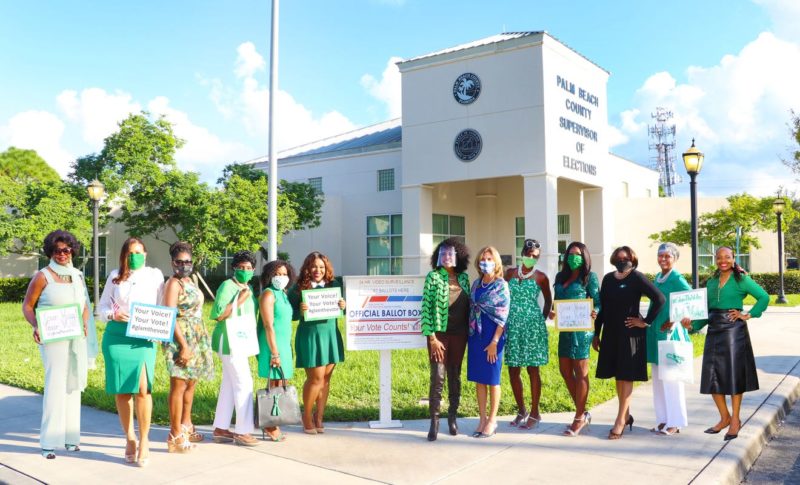
7. Hosting Open Houses. Election offices throughout the country have invited the public to open houses in an effort to educate voters, increase transparency, and consequently build trust. When voters understand what goes on behind the scenes, their confidence in the process increases. In recent years, several jurisdictions that updated their voting equipment, including Knox County, Tennessee, Preble County, Ohio, and Venango County, Pennsylvania hosted open houses to introduce voters to the new machines. These efforts help voters become more familiar with new processes, and have the added benefit of making Election Day run just a bit more smoothly.
8. Hiring Disinformation Experts. Prior to the presidential election, Connecticut Secretary of State Denise Merrill was concerned about disinformation campaigns on social media. Understanding that such campaigns could confuse and suppress voters, Merrill hired a disinformation expert to report and correct disinformation, particularly from foreign actors, in real-time. Election officials have an ever-growing list of responsibilities, so when budgets allow, hiring an expert can alleviate some of their stress.
9. Practicing Post-Election Audits. The vast majority of states require some type of post-election audit, which guards against errors and manipulation. New Hampshire doesn’t require audits yet, but the Secretary of State’s office has been studying audits and conducting test audits to understand how they might work for future elections. Jurisdictions like Glynn County, Georgia conduct pilots to get a “trial-run” before the policies become official. Even Colorado, a state well-known for its audits, allows a “Practice Period” 20 days before each election when counties can practice the audit. Our training courses, Introduction to Post-Election Audits and Implementing Risk-Limiting Audits, are another great way to prepare and improve your audits.
After an Election:
10. Hosting Live Streams of Ballot Counting. More and more election offices around the country are livestreaming their ballot counts, allowing anyone to tune in and watch election administrators sort ballots, verify signatures, review envelopes, and tabulate votes. In places like Jefferson County, Kentucky, and counties throughout Nevada and New Jersey, election administrators are hoping that watching the monotonous ballot counting process will increase transparency while quelling voters’ fears about fraud. It is worth noting that sometimes these efforts can backfire if election officials don’t take the necessary precautions. Simple action steps like including the date, time, and location on the feed can prevent live streams from being taken out of context or misleadingly reframed.
11. Allowing the Public to Observe Canvassing Boards. In Palm Beach County, Florida, the public was able to observe the canvassing board performing its post-election duties in an exciting new way this year. While safely socially distancing in an outdoor tent specially erected for the occasion, people directed their attention to five large TV screens. Instead of showing the canvassing board members themselves, cameras zoomed in on ballots with markings or signatures in question, allowing the public to get an insider’s view of the ballot review process.
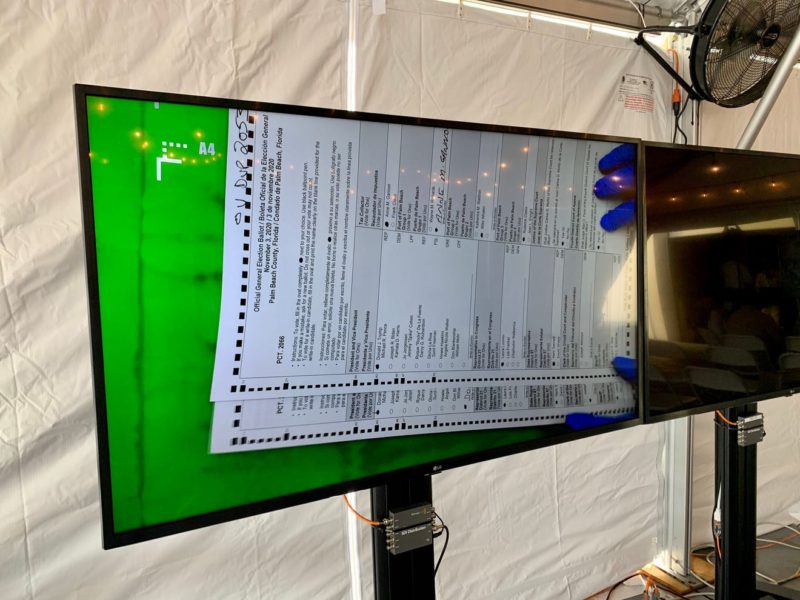
12. Conducting Risk-Limiting Audits. Several states, including Georgia and Michigan, conducted risk-limiting audits, or RLAs for the first time this year. RLAs are a process designed to detect errors, check the accuracy and integrity of voting systems, and ensure that votes were counted properly. Ultimately, they encourage the public to be confident that a contest has been certified with the correct winner. Only Colorado, Virginia, and Rhode Island require RLAs, while nine other states have pilot programs or optional RLAs. If your jurisdiction is considering RLAs, our training courses on post-election audits and risk-limiting audits are a good introduction.
13. Being Transparent about Errors. Although small errors are a normal part of the ballot counting process, election officials might be hesitant to disclose them and risk voters’ trust. But being transparent with voters can actually increase their confidence in election officials’ ability to detect and correct errors. When you disclose errors, just be clear about the fact that audits and recounts are designed to catch these mistakes. Finding errors is evidence that the system worked, not proof that it failed. In Dane County, Wisconsin, for example, the county clerk informed the public that a four vote discrepancy was corrected during a partial recount. The clerk stated, “It’s not great to make an error, but we cross check our work, we make sure it’s accurate and transparent…it’s a very small change in the numbers, but we want everyone to understand why that change occurred.” Similarly in Atlantic County, New Jersey, the Board of Elections shared that the error percentage rate during a post-election audit was less than 1%, and that “no single batch showed more than a two-vote variance one way or the other.” Statements like these assure voters that election officials are competent, deliberate, and thorough.
14. Displaying Election Results Clearly. In 2019, The Denver Elections Division won the Election Center Professional Practices Program award for its interactive election night results dashboard. The powerful tool clearly and quickly displays maps of each precinct, as well as bar graphs for each candidate in a selected contest. Voters no longer have to search through rows and rows of spreadsheets in order to find accurate results, and the robustness of the data assures voters that their votes were counted in a meaningful way.
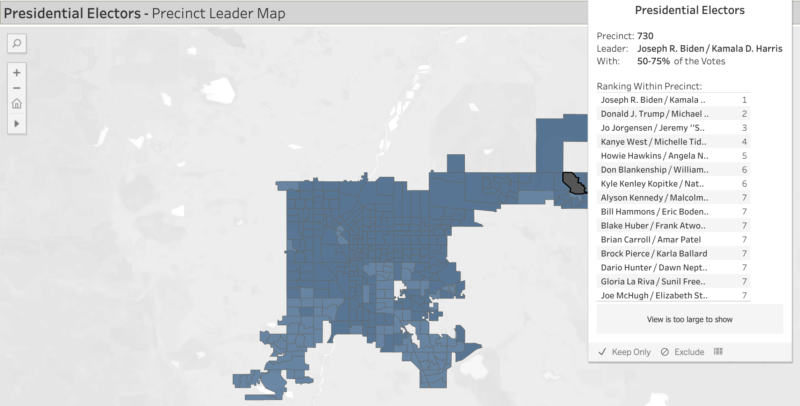
Communicating with the Public
Before an Election:
15. Emailing Constituents. In 2018, California’s Secretary of State emailed 6 million registered voters for the first time to provide them with trusted election information. The electronic campaign was part of the award-winning VoteSure initiative designed to raise awareness about election misinformation online and deliver official election resources, especially to hard-to-reach voters. Sending out an email newsletter is an excellent way to boost voter engagement, while ensuring voters are up to date on everything an election office is doing to keep elections safe and secure.
16. Creating Informational Videos. Another creative way to provide voters with election information is to put together an instructional video. These can be especially useful for updating voters on new processes, like the California Secretary of State’s video explaining the state’s new ballot tracking system, or Salt Lake County, Utah and Somerset County, New Jersey’s videos with instructions about mail-in voting. Videos can also offer insight into the integrity of the election process; Pennsylvania’s Department of State put together two excellent videos explaining election security measures in place at the state and local level. Keep in mind that shorter is usually better; we love each of these examples because they are all just about two minutes long. Sharing the videos on social media is another best practice to reach as many voters as possible.
17. Launching an Election Security Media Campaign. Leading up to the presidential election, the Virginia Department of Elections launched a “Defending Democracy” media campaign with the goal of communicating its commitment to election security. The campaign included radio ads and high quality videos highlighting the work of local and state election officials. Their website also features clear information about the safeguards in place to protect and verify each vote.
18. Sharing Your Dedication to Training with the Public. Many election offices across the country participate in cybersecurity trainings or workshops on a regular basis, but the public doesn’t usually know about it. In September, the Tennessee Secretary of State spoke at a cybersecurity and disinformation forum and a local media partner, The Tennessean, was selected to report on the event. By involving local media, community members could better understand how election officials were implementing best practices in preparation for the election in November. We also appreciate this tweet from the West Virginia Secretary of State, which shares pictures from a training session to teach staff to use a scanner to securely count absentee ballots.
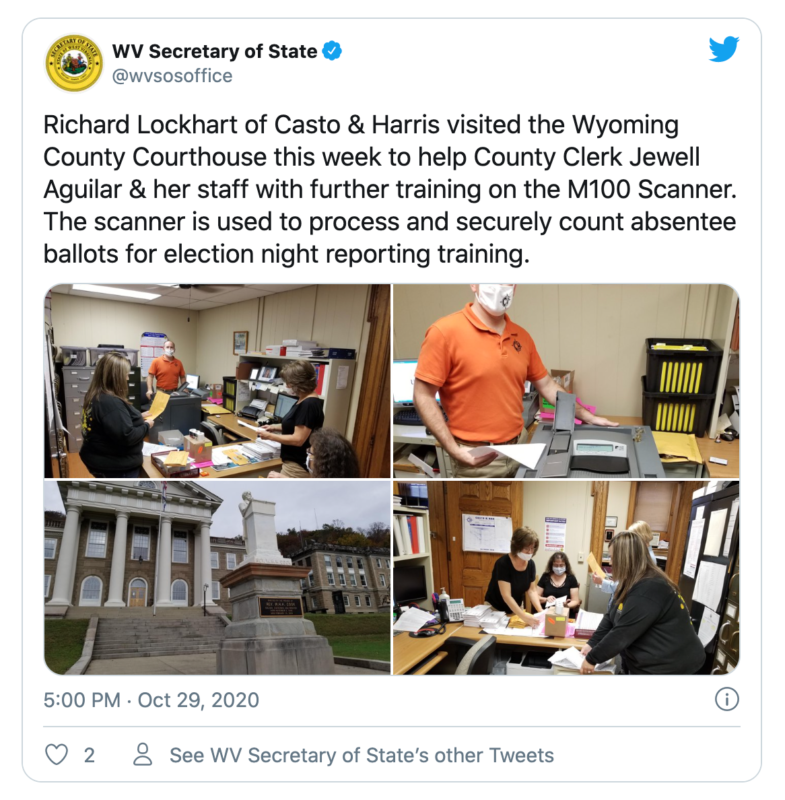
19. Accepting Podcast and Radio Invitations. Accepting invitations to speak on a podcast can be a wonderful way for voters to hear directly from an election office. In September, Washington D.C.’s public radio station hosted the secretaries of state from Washington, Georgia, and Virginia to speak about their plans in place to ensure the validity of the election. Hearing about their comprehensive plans could help put voters’ minds at ease before they cast their ballots. Our free training course, Cybersecurity 301: Communications, includes some great tips on how to proactively build media allies.
20. Working with Documentary Producers. Participating in documentaries and other short videos is yet another way for election officials to educate the public about election processes. Just before the presidential election, county clerks in Wisconsin were featured in a short documentary designed to inform the public about their dedication to accurately count votes. The six-minute video highlights the many security measures in place, as well as the clerks’ frustration over voting fraud allegations.
21. Utilizing a Mobile App. More and more election offices are utilizing mobile apps to bring trusted election information to voters’ fingertips. Both Alabama and Louisiana have statewide apps, while counties throughout the U.S., including Lake County, Indiana and Galveston County, Texas offer local apps. These tools allow voters to contact election officials with questions or concerns, track their mail in ballots, explore election results, and receive updates in real time.
22. Verifying Social Media Accounts. The coveted blue check mark on Twitter and Facebook accounts signals to users that an account is verified and reliable. Knowing the importance of being a trusted source of election information, Arizona’s Secretary of State worked with social media companies earlier this year to get county election administrators’ accounts verified. It’s a simple step toward boosting the public’s trust in the information they view online. Once your accounts are verified, it’s a great idea to post the news on social media, like Minneapolis, Minnesota did, to share the excitement with voters. Our free webinar, Engaging Voters on Facebook, includes tips on getting verified on Facebook.
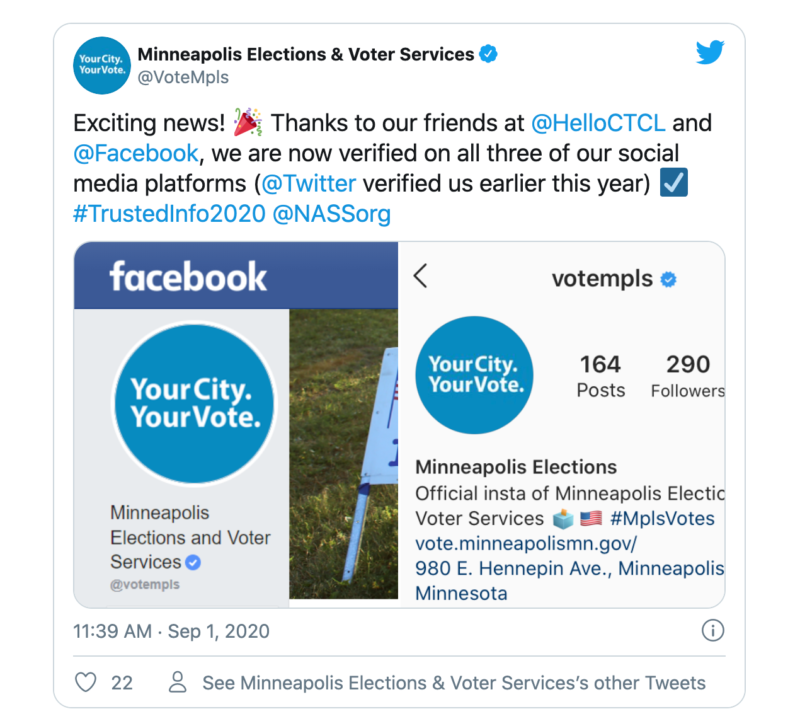
23. Combating Misinformation on Social Media. Election-related misinformation overwhelmed election officials this year, on top of the added pressure caused by the pandemic. But several election administrators, like Sonoma County, California and the New Mexico Secretary of State fought back and set the record straight when rumors or conspiracies arose before the November election. Both of their tweets are great examples that use clear, eye-catching visuals and popular hashtags, such as #TrustedInfo2020, in order to get accurate information to voters fast. Our free training course on Combating Election Misinformation has more in-depth best practices, including the misinformation checklist for election officials.
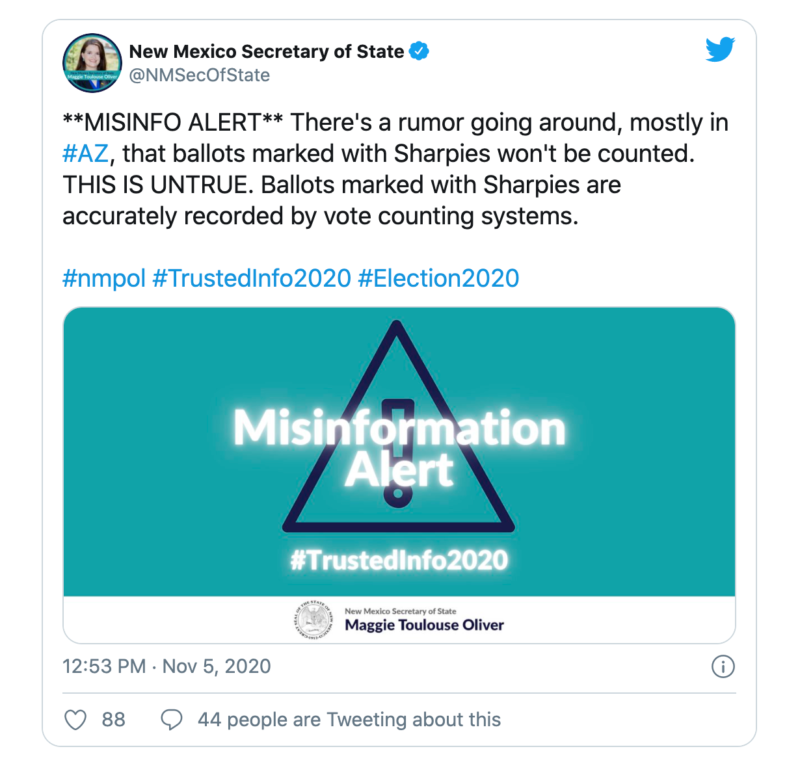
24. Answering Phone Calls. Calling up their local election office to ask questions is one of the easiest ways for voters to clear up any doubts they may have, especially in regards to misinformation. In Philadelphia, election officials fielded hundreds of phone calls from the public every day for months before the election. And in San Luis Obispo County, California, the election office hired two people just to answer phone calls. If offices have room in their budgets to take on new hires to field calls, voters will be reassured to hear directly from election officials. That being said, you can reduce phone calls about logistical issues by updating your election website with answers to voters’ most frequently asked questions. This helps ensure that phone calls are reserved for serious concerns. Our free training course, Improving Your Election Website shares tips for making information usable online. And our Election Website Template walks you through the process of building a website.
After an Election:
25. Sharing Updates about Audits. Keeping voters updated throughout the post-election audit process is a simple and effective way to increase their confidence that the election ran smoothly. Social media posts, like these from Jefferson County, Colorado, and Maricopa County, Arizona, are excellent examples of celebrating an audit with zero discrepancies or a 100% match. Jefferson County also posted a fantastic one minute video clip explaining how the post-election audit process works. And we love this tweet from Arapahoe County, Colorado because of its clear language: “Today’s Risk-Limiting Audit compares marked ballots against computer records, making sure every vote was recorded the way voters intended.” If you’d like some guidance, our Post-Election Audit courses include best practices on communicating about audits.
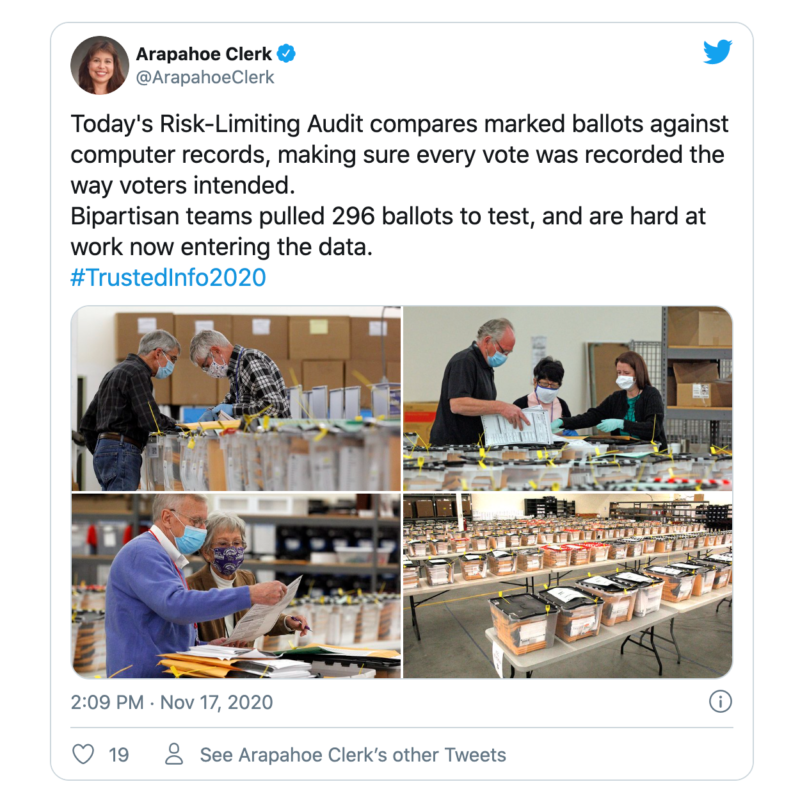
26. Publishing Fact Checks on Election Websites. After the November election, false allegations of fraud and misconduct were rampant. In an effort to combat misinformation, several election offices created web pages dedicated to publishing fact checks. Michigan’s Secretary of State’s website does an excellent job of laying out the facts, so that voters can be equipped with trusted information from their election officials. Keep in mind that it’s a best practice to avoid repeating falsehoods when correcting false information. For example, rather than saying, “It’s not true that deceased voters’ ballots are counted,” Michigan’s website clearly and simply states, “Deceased voters’ ballots are not counted.”
27. Combating Misinformation on Social Media (Once Again). Combating misinformation after an election is just as important as before an election. Both Georgia’s Secretary of State and Louisville, Kentucky’s former director of elections have efficiently fought back against post-election misinformation on Facebook and Twitter. The fact is, monitoring social media is a responsibility that should be carried out year-round. Simple reminders, like this tweet from the Kansas Secretary of State, position election officials as trusted sources of election information that voters can always rely on. Our free training course on Combating Election Misinformation includes an actionable checklist and a step-by-step framework for responding to misinformation.
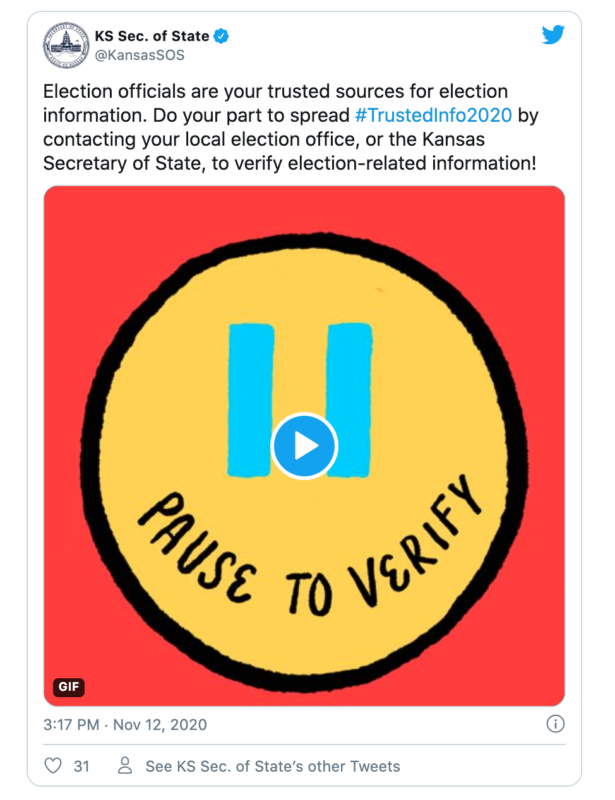
28. Writing Letters to Voters. In order to assure voters that the November election was carried out with integrity, Maricopa County, Arizona released a public letter to voters stating facts about the voting equipment used and the overall process. The letter asserts, “No matter how you voted, this election was administered with integrity, transparency and in accordance with state laws.” Sharing a well-drafted letter to the editor is another compelling strategy to reassure voters that an election was conducted in a safe and secure manner. Such letters may praise clerks for their competence and professionalism, like this one from New Mexico. Others might respond to attacks on the election system, such as this one from Oklahoma. In that letter, a former election officer countered claims that election officials were motivated by partisanship by sharing his experience of administering elections for 13 years.
29. Talking to the Press. After the presidential election, the Ohio, Idaho, Maine, and Minnesota Secretaries of State, among other officials, spoke with ABC News to confirm that the election was transparent, safe, and fair. Election officials from virtually every state agreed to interviews with The New York Times to speak about the absence of major voting issues or cases of fraud. Speaking to national news outlets is a quick and easy way to get election officials’ voices to massive amounts of voters, assuring them that they can trust the election system. As part of our free Cybersecurity 301: Communications course, we created short videos on preparing to talk with the media and talking with the media.
30. Sharing Personal Stories. Demonstrating that election officials are real people who care deeply about elections can restore the public’s faith in election systems. Sharing personal stories, like this one about the Brunswick County, North Carolina Elections Director who had to challenge her own deceased mother’s ballot, exemplifies election officials’ dedication to administering fair elections. By understanding how seriously they take their jobs, voters can trust election officials and the election process.
What else are you doing?
What is your office doing to boost voter confidence? What have you seen other offices do? We’d love to hear from you! Let us know by emailing [email protected].
